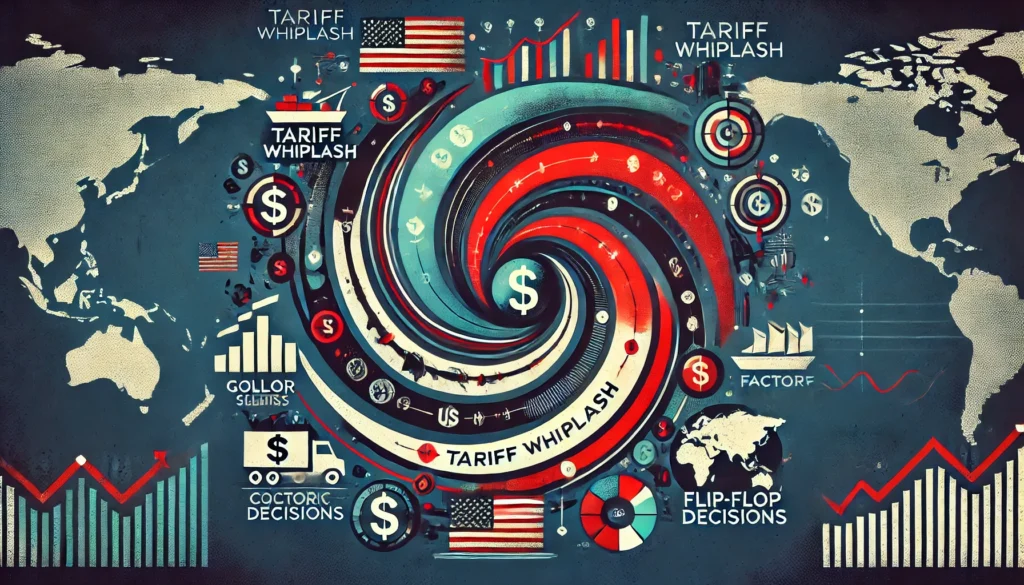Published: Sunday, April 13, 2025 ✍️ By: Global Trade & Policy Intelligence Desk 🌐 Source: GlobalWorldCitizen.com
 Global Markets Rattled as U.S. Tariff Policy Swings Wildly
Global Markets Rattled as U.S. Tariff Policy Swings Wildly
Since President Donald Trump declared April 2nd as “Liberation Day” for U.S. trade policy, the administration has made eight major reversals in tariff strategy—shocking international markets, trade allies, and investors worldwide. These ongoing tariff flip-flops are fueling fears of global trade instability, eroding economic confidence, and reshaping the future of U.S. diplomacy and global supply chains.
At GlobalWorldCitizen.com, we unpack the full timeline of shifts, expose what’s at stake, and provide AI-powered insights into the broader consequences of America’s unpredictable trade war playbook.
 Timeline of Trump’s 2025 Tariff Policy Reversals
Timeline of Trump’s 2025 Tariff Policy Reversals
February 7
Trump calls for “reciprocal tariffs”, demanding equality in how nations tax U.S. exports.
February 13
A presidential memo orders tariff formulas to be recalculated based on broader trade restrictions, not just trade imbalances.
 April: Tariff Chaos Begins
April: Tariff Chaos Begins
April 2 – Liberation Day
Trump announces sweeping global tariffs (10% to 50%), impacting 180+ countries.
But soon after:



April 3



April 4–6
-
Treasury Secretary says tariffs “can’t be undone overnight.”
-
Economic advisers say 50+ countries are in talks.
Flip-Flop #5: Conflicting signals emerge about whether deals can be made.
April 9 – Tariffs Go Live
-
At 12:01 a.m., tariffs take effect.
-
At 1:18 p.m., Trump backtracks:
Flip-Flop #6: Announces a 90-day pause, except for China (tariffs rise to 125%).
April 11
Trump doubles down:
-
10% is now “the floor”
-
China tariffs may hit 145%
But that evening…Flip-Flop #7: Smartphones, computers, electronics quietly exempted by U.S. Customs.
April 13
Trump claims “no exemptions were announced”—despite evidence.
 What Remains Unclear
What Remains Unclear
-
Are tech and pharma exemptions permanent?
-
Will “friendly nations” see baseline tariff relief?
-
Is this a long-term strategy—or improvisation?
White House sources suggest internal conflict between economic nationalists and internationalists, further deepening confusion.
 GlobalWorldCitizen Insight: Chaos in Global Trade Leadership
GlobalWorldCitizen Insight: Chaos in Global Trade Leadership
These erratic moves signal deeper flaws in the U.S. approach to 21st-century trade diplomacy:
Global Consequences:
-
Market volatility across Asia, Africa, and Europe
-
Supply chain disruptions for tech and manufacturing
-
Allies reconsidering U.S. reliability as a trade partner
-
Developing nations stuck in uncertainty on export tariffs
 Bipartisan Criticism Mounts
Bipartisan Criticism Mounts
“The White House has no strategy and is rapidly losing credibility.”
— Rep. Ted Lieu, D-Calif.
Lieu’s words echo a growing consensus: the Trump administration’s tariff policy lacks consistency, causing more economic uncertainty than strategic gains.
 Final Word from GlobalWorldCitizen.com
Final Word from GlobalWorldCitizen.com
As the U.S. wields tariffs like poker chips, the global economy is left to pick up the pieces. For investors, businesses, and nations alike, the need for predictable policy and fair diplomacy has never been more urgent.
GlobalWorldCitizen.com will continue to track:
-
Real-time updates on U.S. tariff decisions
-
Global economic impacts and supply chain shifts
-
Strategic analysis from leading economists, diplomats, and global business leaders



